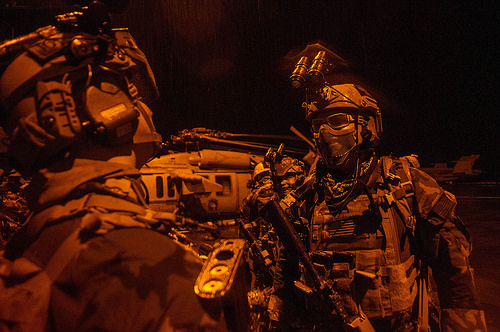Tiny Team Beefs Up Marines’ Comms To SOCOM
Posted on
BALLSTON, VA: A soufflé is fluffy but a SOFLE – a brand new military acronym that stands for Special Operations Forces Liaison Element — is sinewy and powerful. Just ask Marine Lt. Col. Andrew Christian, who led the first such unit for the 11th Marine Expeditionary Unit during a seven month deployment to the Pacific and Middle East that ended Feb. 23.
“Their sole purpose in life is to be the connective tissue between two organizations,” Christian said of his six-man SOFLE, (pronounced “SOFF-lee”), which kept the commanders of the 2,200 11th MEU marines aboard the three-ship USS Makin Island Amphibious Ready Group in constant touch with what special operators in their vicinity were doing.
The SOFLE is a novel concept that does away with the tried but abandoned idea of keeping a full Marine Corps Forces Special Operations Command (MARSOC) company aboard an ARG ship waiting for something to happen. “There was too much work to do on the ground to keep those guys on the ship waiting for something to happen,” Christian said.
Col. Matthew Trollinger, 11th MEU commander, told a Potomac Institute briefing that having the SOFLE, with the MEU/ARG, (pronounced like a cat debating a pirate), as it traveled was a major advantage.
“I could not have had better perspective or understanding of what was expected of the MEU as we were supporting SOF in the different things that they were doing,” Trollinger said. “Traditionally when MEUs go out, we don’t know necessarily” just what special operators in the deployment area are doing or might need from the MEU/ARG, “so we have to get up to speed pretty quickly, which we call a cold start. In this case, I’ve got a team that is pulling everything that they have and giving it to me and I am much better informed.” That “enables me to have a warm start everywhere,” Trollinger said.
The SOFLE was able to do that because of the knowledge each team member possessed. In addition to himself as the officer in charge, Christian said, his SOFLE included a Navy SEAL as senior enlisted advisor, one intelligence specialist from the Army’s 1st Special Forces Group, another from the Naval Special Warfare Command, and two communications specialists, one from MARSOC and one from Air Force Special Operations Command.
As the MEU/ARG traveled through the Pacific Command and Central Command areas of responsibility, the SOFLE was joined by a liaison officer from the PACOM and CENTCOM special operations commands as well. The six-man team also came with a communications suite not normally found with a MEU/ARG: five systems allowing the SOFLE to plug into the global SOCOM radio and computer network at unclassified, Secret, Top Secret and other levels.
They used that sinewy connectivity to work with special operators 31 times, which Christian said included not just training but real operations. Three members of his team went ashore at Djibouti, for example, to provide liaison and deconfliction between special operators and the MEU/ARG team during two sensitive missions.
Born of a Special Operations Command war game two years ago and pushed by the then-SOCOM commander Adm. William McRaven and Marine Corps commandant Gen. James Amos, both now retired, the SOFLE is said to have a fan as well in Army Gen. Joseph Votel, the current SOCOM commander.
“This is going to continue,” Christian said. He added that all indications point toward SOCOM rapidly moving SOFLE from a proof of concept to a program of record.
Subscribe to our newsletter
Promotions, new products and sales. Directly to your inbox.

